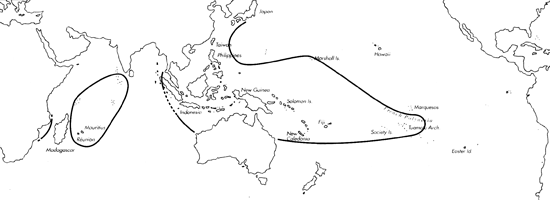Range: C. a. paulucciae: Mozambique, Mascarenes, Seychelles, Maldives, Chagos Is., W. Thailand, and N. W. Australia; C. a. aureus: Japan and Philippines to Queensland and New Caledonia and to Tuamotu Archipelago.
Description: Medium-sized to moderately large, moderately solid to solid. Last whorl usually narrowly conoid-cylindrical to conoid-cylindrical in C. a. paulucciae (Pl. 66, Figs. 4-7), also narrowly cylindrical to cylindrical, ventricosely conical or ovate in C. a. aureus (Pl. 66, Figs. 1-3). In C. a. paulucciae, outline of last whorl convex at adapical fourth, almost straight below; in C. a. aureus, outline convex to almost straight and parallel-sided at adapical two-thirds, concave at left side below. Aperture somewhat wider at base than near shoulder. Shoulder angulate to rounded, usually more angulate in C. a. aureus. Spire of moderate height, outline straight. Larval shell of 2.5-3 whorls and maximum diameter 0.75-0.9 mm in C. a. aureus, of about 3 whorls and with a maximum diameter of 0.8-0.9 mm in C. a. paulucciae. First 4-6 postnuclear whorls tuberculate. Teleoconch sutural ramps flat to slightly concave, with 0-2 increasing to 4-10 weak spiral grooves; additional spiral striae on latest ramps. Last whorl with closely spaced, granulose to smooth spiral ribs from base to shoulder, sometimes weak to obsolete toward shoulder; in C. a. paulucciae, ribs usually smooth and generally obsolete above centre.
| Shell Morphometry | ||
|---|---|---|
| L | 40-80 mm | |
| RW | 0.13-0.36 g/mm | |
| RD | 0.46-0.53 | |
| PMD | - | |
| (-C. a. aureus 0.70 - 0.81;-C. a. paulucciae 0.75 - 0.84) | ||
| RSH | 0.12-0.23 | |
Ground colour white, often suffused with pink in C. a. paulucciae. Last whorl with a network of fine light to dark brown lines and yellowish brown blotches. Lines forming zones of many tiny to small and a few larger tents, arranged in 3-5 axial and 3 interrupted spiral bands, below shoulder and centre and at base. Blotches grouped in 2 broad and often some additional narrow spiral bands, interspersed with broad blackish brown axial lines. Larval whorls and first 2.5-4 postnuclear sutural ramps immaculate white in C. a. aureus; in C. a. paulucciae, apex cream to pink, larval shell and about first 2.5 postnuclear sutural ramps immaculate. Following sutural ramps matching last whorl in colour pattern. Aperture white in C. a. aureus, white to light pink in C. a. paulucciae.
Periostracum pale brown, thin, translucent, smooth.
In C. a. aureus, animal mottled light and darker brown (Richards, pers. comm., 1989).
Radular teeth with 2 opposed barbs adapically; serration present, basal spur absent (James, 1980).
Habitat and Habits: C. a. aureus in 3-30 m on coral reef, in coral rubble and beneath coral rocks; C. a. paulucciae in 30-50 m in sand or coral rubble.
Discussion: C. a. aureus resembles C. auricomus, and C. a. paulucciae is similar to C. legatus; for comparison, see the Discussions of those species. C. a. aureus (Pl. 66, Figs. 1-3) has a West and Central Pacific distribution, while C. a. paulucciae (Pl. 66, Figs. 4-7) is restricted to the Indian Ocean. Intermediate specimens (shape, sculpture, apex colour) are known from the Indian Ocean and from Philippines. The conchological differences between C. aureus and C. paulucciae are often considered to justify separation at the species level (e.g. Richard, 1990). With regard to the generally disjunct geographical ranges, the different bathymetrical ranges, and to the intermediate shells, we favour the status of geographical subspecies.

C. aureus range map
This section contains verbatim reproductions of the accounts of 316 species of Conus from the Indo-Pacific region, from Manual of the Living Conidae, by Röckel, Korn and Kohn (1995). They are reproduced with the kind permission of the present publisher, Conchbooks.
All plates and figures referred to in the text are also in Röckel, Korn & Kohn, 1995. Manual of the Living Conidae Vol. 1: Indo-Pacific Region.
The range maps have been modified so that each species account has it own map, rather than one map that showed the ranges of several species in the original work. This was necessary because each species account is on a separate page on the website and not confined to the order of accounts in the book.